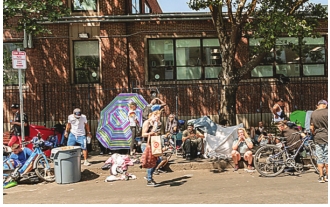The profile of Boston's illicit drug market is shifting away from simple opioids toward mixes of substances that can be harder to treat.
Experts nationwide are reporting that Fentanyl is increasingly prevalent and even sought out intentionally by some drug users despite once being feared for its lethal potency. The Centers for Disease Control (CDC) says Fentanyl is 50 times stronger than heroin and 100 times stronger than morphine. It accounts for a wildly disproportionate share of overdose deaths but is now so common on the street that it’s rare to find an illicit fix without some.
According to a report by NBC News, intentional Fentanyl use is becoming more common as the opioid epidemic worsens. Once largely confined to the West Coast, people nationwide struggling with drug addiction are turning to Fentanyl for its accessibility and potency. Dr. Daniel Ciccarone, a professor of family community medicine at the University of California, told NBC he expects smoking Fentanyl “will be the norm within a year” among heavier drug users.
State Rep. Jon Santiago who represents the South End, however, pushed back slightly against the suggestion people are deliberately seeking out the drug.
“Fentanyl use is
intentional as far as Fentanyl is all we have,” he said. “People can’t
really pick and choose; the illegal market is all Fentanyl. My
understanding from talking to people on the ground is that it’s
everywhere. And when you look at the overdose deaths, well over 90% of
those are secondary to Fentanyl.”
As
a synthetic opioid, Fentanyl can be produced cheaply in a lab with no
need for a vulnerable and costly agricultural supply line. A 2020
intelligence report from the Drug Enforcement Administration (DEA) noted
that in addition to actual Fentanyl being smuggled into the country,
production precursors can be shipped by mail services from Asia to North
America, then smuggled as needed to production facilities.
“It’s
taken off because it can be made in labs across the world, which means
so much more of it can be made and transported here. That’s
significantly more profitable than the number of hectares of opium you
need to create heroin,” said Santiago.
The
changing face of Boston’s drug market goes beyond just Fentanyl. A
variety of drugs such as methamphetamines are now entering common use,
some with fewer treatment options. While the total amount of
methamphetamines doesn’t yet rival opioids, its higher growth rate has
lawmakers nervous.
“We’ve
known for years that what we’re really facing is a Fentanyl epidemic.
Now some would argue that we’re facing a poly-substance use epidemic.
Six, seven years ago people were just using heroin, but now people are
mixing and combining, particularly with an increase in the level of
methamphetamines,” said Santiago. “The problem is that there doesn’t
currently exist a real treatment pathway for methamphetamines. For
opioids you can detox, there’s a whole host of different services, but
for methamphetamines we don’t have those things developed yet.”
Data
from the CDC indicates that overdose deaths reached a record-breaking
107,000 annually during the pandemic. The organization attributed an
increased share of those deaths to both synthetic opioids and
methamphetamines.